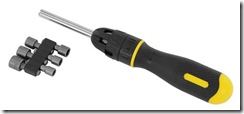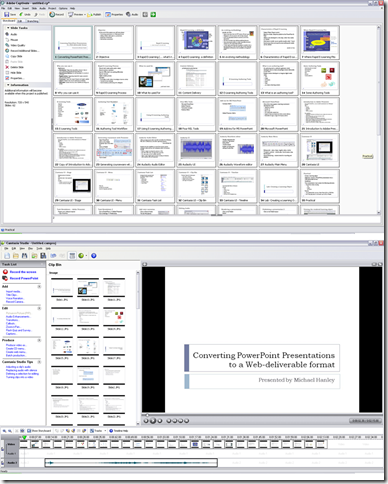In the previous two blog posts, I outlined – at a very high level - some of the features and functionality of TechSmith Camtasia Studio and Adobe Captivate, and in today’s post I will provide a equally high level assessment of these products, not so much in comparison to each other, but rather more at tools that enable learning professionals to create immersive, media-rich demonstrations and learning objects.
Now read on…
Writing this review has proven to be a much more difficult (and time-consuming) task that I had anticipated it would be; in fact, I can say that I experience a mild cognitive dissonance whenever I’m asked the question “which do you prefer (or recommend): Camtasia or Captivate?”
The answer is I don’t know. Or more accurately, I still don’t know. More on this later. Like most people (in any industry) I tend to have a single ‘weapon of choice’ for each task I undertake. Last weekend I spent some time doing some DIY around the house for example, and despite owning many screwdrivers, I always return to my trusty old Stanley DynaGrip 10,  pretty much regardless of the gluing and screwing job I’m doing. Similarly when I post-produce video I use one editor – Vegas Video, when I edit audio the files are authored in SoundForge, and I use DreamWeaver to do 95% of my HTML and website- related production. But when it comes to authoring demos? Well… there I have a problem. Inevitably I run mentally run through the dialog that I am about to share with you, dear reader.
pretty much regardless of the gluing and screwing job I’m doing. Similarly when I post-produce video I use one editor – Vegas Video, when I edit audio the files are authored in SoundForge, and I use DreamWeaver to do 95% of my HTML and website- related production. But when it comes to authoring demos? Well… there I have a problem. Inevitably I run mentally run through the dialog that I am about to share with you, dear reader.
Adobe Captivate and TechSmith Camtasia Studio are similar e-learning content development tools with uniquely different strong points. If you’re creating a software demo, or a PowerPoint presentation to deliver online, Camtasia is a better application; conversely, if you’re making interactive web-based training, or a complex software demonstration, Captivate is superior is definitely the tool for the task.
Even where their functionality converges, their operating procedures and user interface are so different that each will probably appeal to different users. If (like me) your background is in media production, you’ll find Camtasia easy to learn and use, and Captivate frustrating. On the other hand, if you’re used to authoring content in PowerPoint, you’ll find Camtasia a strange, and Captivate more intuitive and fit-for-purpose.
Figure 1. Captivate UI (above), Camtasia UI (below).
[Click image to enlarge]
Beyond these, however, are certain functions at which one product excels and the other either doesn’t perform or performs quite poorly. For example, Camtasia excels at capturing streaming video content, which Captivate cannot do. If you need to ‘pan and scan’ a close-up of a screen element of the content that you’ve captured, Camtasia is your only choice. However, the reverse pertains if you’re creating a quiz - Captivate offers a much richer toolset. Similarly Captivate’s ability to generate Word or PDF versions of files for hardcopy distribution is a fantastic timesaver.
Indeed, the more you use both tools, the more you begin to realize that if you’re authoring a range of e-learning, demonstration, and presentation projects, you probably really need both .
Using Camtasia
Like most screen-capture utilities, Camtasia captures a video of the screen as you interact with it, with added audio if you enable narration, as well as Picture-in-Picture (PIP) video if you add a webcam. The resultant CAMREC output file is a recording of all of the audio, video and interaction elements. In editing mode, Camtasia enables the addition of multiple tracks for captions, breakout boxes, callouts, PIP, quizzes, and so on.
Using Captivate
Captivate works differently. Rather than capturing one multiplexed file, Captivate captures the user’s interactions as a series of screens, each containing one mouse click and movement. Very much like its progenitor Flash, Captivate stores each object of each captured screen as a separate element. As with Camtasia, you may add additional content enhancements – 508-compliant closed captioning, callouts, quizzes, etc in post-production.
Audio
Both applications enable the author to either record audio narration in real time during capture time, or import MP3 or WAV audio in post-production. In my experience, Captivate audio recorded in real time loses synchronization over the duration of the recording: this becomes especially noticeable in 20-minute-plus recordings and can be very frustrating to remediate. However you can add post-content captured audio slide by slide (tedious), or by importing a completed audio file. A very neat feature of Captivate is that it recognizes audio markers, so if you include these in your WAV or MP3 file, it will synchronize with the slides in the presentation. I have also noticed that the audio generated by Captivate can be pretty ropey (even though it’s MP3 format) – in fact, at some of the lower sample- and bit rates, it reminds me of the horrible .VOX format I had to use in my Authorware days, back in the last century.
In my view, Camtasia Studio provides a much more easy-to-use and intuitive audio recording and editing experience. The fact that you can see all the audio on a timeline layer means that you can see how the audio fits in context with the presentation's ‘big picture.’ The ability to split audio and move it around the timeline is an added bonus. Similarly, I feel that the audio enhancement features – normalization, noise reduction (NR) and so on – are easier to preview and use in Camtasia. In terms of outputs, there no end to your choice of formats – MP3, WAV, and WMA. The facility to render podcast-formatted audio is a very cool feature that Captivate just can’t compete with.
This concludes this part of my head-to-head review.
Next time: Video editing, content rendering, and my conclusions.
--






9 comments:
This is an excellent overview. As I mentioned before, I have been disillusioned about Captivate, but once I recognize what it does well, I can manage.
The problem is that on the job you typically are able to choose one or the other, not both
Thanks for the review. I'm starting to test both and this review has given me a few things to think about during my own tests. Very helpful.
Thanks for reading The E-Learning Curve and for taking the time to comment. I'm very pleased that my review is proving of value to - let me know if you want to talk to me about specifics and I'll be happy to assist if I can.
Michael
--
>>>>A very neat feature of Captivate is that it recognizes audio markers, so if you include these in your WAV or MP3 file, it will synchronize with the slides in the presentation.
Hi michael, How do you insert markers and how do you synchronize with captivate slides. Can you please elaborate.
Thanks for your comment Krishna. I'll post about this (and may be include a demo) over the next few days.
Michael
--
''The facility to render podcast-formatted audio is a very cool feature that Captivate just can’t compete with.''----
Michael ,do you know that Captivate 4 has export to Podcast feature. It's available under File --> export--> To Podcast. You may want to check it out.
-Suresh
Michael, thanks for the article it is very interesting and informative. I found another product that you might want to compare with Camtasia and Captivate for creating e-Learning. It is called Scate Ignite and can be found at http://www.scateignite.com
Cheers
Very thoughtful discussion of the pro& cons which I thought was quite accurate having been evaluating these 2 products myself for the last 2 months.
Do you know anything more about Captivate's ability to gather data in quiz mode that can be exported real-time to database for an individual? I want to be able to aggregate data for analysis over multiple small interactions with my clients & the usability of quiz info is very important.
I can't figure out how to get the export file of data for Camtasia quizes - thus the comparison is moot at this time. Any input into this?
Sherlock, you might find this blogpost helpful:
http://www.captivate4.com/2009/07/01/using-advanced-actions-to-store-and-show-a-users-answers-in-a-quiz/
Post a Comment